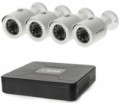Video channels
The number of video channels that the set's recorder is capable of simultaneously processing. In fact, this is the number of cameras that the device can simultaneously work with; it is technically possible to connect more cameras, but this will require additional equipment — such as quadrators.
The choice for this parameter depends on how extensive and extensive the observation system is planned to be built. At the same time, it should be noted that modern technologies allow combining several registrars into a system with a single control; therefore, for numerous cameras, it is sometimes easier to purchase several relatively modest kits than one multi-channel one.
Max. capacity
The largest storage capacity with which the recorder is able to work normally.
The more capacious the drive, the higher the processing power of the system in which it is used should be. Therefore, any modern registrar has limitations on disk capacity. However, even in the most modest models, this figure is about 2 TB, in most cases this is quite enough to work with the capabilities provided in this particular registrar.
Camera model
A model of pointed cameras supplied with a video surveillance kit. Knowing this data, you can find detailed information on the cameras and clarify their characteristics. Also, if you buy additional cameras of the same model, you don't have to worry about compatibility.
Martix type
The type of matrices used in pointed cameras.
— CMOS. Also known as CMOS. Matrices of this type have good speed, small size, low power consumption and lower cost than CCD. On the other hand, the image quality of CMOS matrices is somewhat worse, and the noise is noticeably higher. However, these shortcomings can be corrected with the help of constructive tricks, and the technology itself is constantly being improved. Therefore, today CMOS matrices can be found both in inexpensive and in fairly advanced cameras; the actual quality of the sensor usually depends on the price category of the camera.
— CCD. Another well-known name is CCD. Compared to CMOS, such matrices are much more expensive and thicker, but they have lower noise levels and noticeably improve image quality. Of the practical disadvantages of CCD, it is worth noting that it is difficult to properly process point light sources; however, in many cameras, this moment is compensated to one degree or another by special technologies. Matrices of this type are typical for cameras of the middle and top levels.
— DIS. The main feature of DIS matrices is the presence of a built-in image processor in the sensor itself. This allows you to achieve good image quality with small dimensions and low cost of the cameras themselves. In addition, DIS matrices are resistant to low temperatures, which makes them especially suitable for outdoor applications.
Horizontal viewing angle
The viewing angle of the directional cameras supplied as standard is horizontal.
Wide viewing angles allow you to cover a large area; this is especially important given that directional cameras are often made stationary. On the other hand, all other things being equal, a larger viewing angle will mean a lower degree of magnification - objects will look smaller, detail will be worse. Therefore, when choosing according to this parameter, you should proceed from what is more important - a wide field of view or “range”.
BNC video input
The number of
BNC video inputs provided in the design of the complete registrar.
BNC is a standard coaxial cable interface used to transmit analogue video signal in video surveillance systems; accordingly, it is found only in analogue and hybrid sets (see "Type"). The number of BNC connectors usually corresponds to the number of analogue video channels supported by the DVR.
RCA audio input
The number of
RCA audio inputs provided in the design of the complete recorder.
The presence of such connectors allows the recorder to receive an analogue audio signal from cameras that have the ability to capture sound, or from separately made microphones. It is worth looking for a set with such capabilities in cases where it is critical to record not only the picture, but also the sound during observation. Note that the number of RCA inputs may correspond to the number of BNC connectors (see above), but may be less.
HDMI
The number of
HDMI connectors provided in the design of the complete registrar.
The HDMI interface is actually a standard for modern video equipment, it is widely used in TVs, monitors, projectors, etc. Usually, in modern registrars we are talking about HDMI outputs. This output allows you to broadcast a digital signal to an external screen, such as a TV; at the same time, both video and audio are transmitted via a single cable, and the bandwidth is enough to work with HD resolutions and multi-channel audio. The recorder itself can be used as an external video player, to play the footage, or directly broadcast video / audio from the camera (cameras) via HDMI. Models where there are more than one such outputs are practically never found.
Video compression format
The format in which the kit recorder records digital video.
This setting determines the codecs required to view content on external devices. When viewing on a computer with codecs, there are usually no problems: their set in modern operating systems is quite extensive, and the missing modules, usually, are easily found and installed via the Internet. But if you plan to view video materials through a media centre, a TV with direct playback via USB, etc. — It is worth making sure that this device supports the appropriate compression formats.
Technical details on different standards can be found in special sources.

